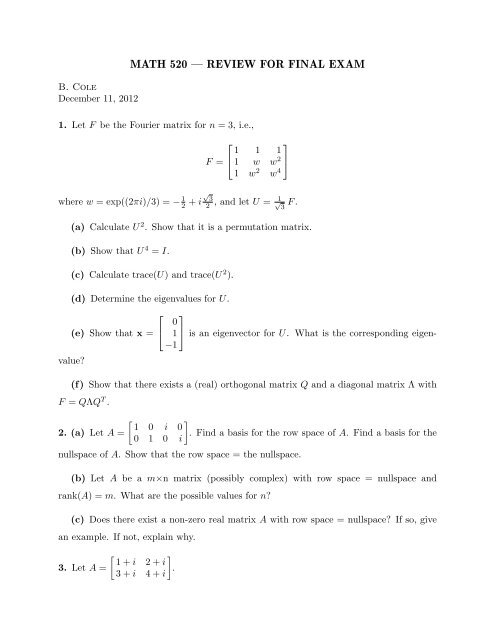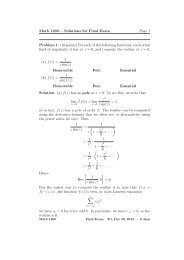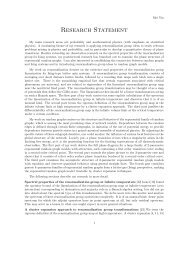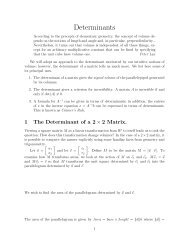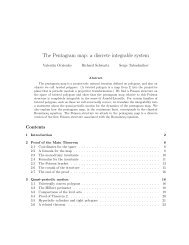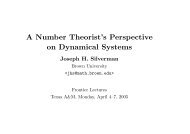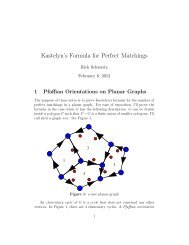MATH 520 — REVIEW FOR FINAL EXAM
MATH 520 — REVIEW FOR FINAL EXAM
MATH 520 — REVIEW FOR FINAL EXAM
Create successful ePaper yourself
Turn your PDF publications into a flip-book with our unique Google optimized e-Paper software.
B. Cole<br />
December 11, 2012<br />
<strong>MATH</strong> <strong>520</strong> <strong>—</strong> <strong>REVIEW</strong> <strong>FOR</strong> <strong>FINAL</strong> <strong>EXAM</strong><br />
1. Let F be the Fourier matrix for n = 3, i.e.,<br />
⎡<br />
⎤<br />
1 1 1<br />
F = ⎣ ⎦<br />
1 w w 2<br />
1 w 2 w 4<br />
where w = exp((2πi)/3) = − 1<br />
2 + i √ 3<br />
2 , and let U = 1 √ 3 F .<br />
(a) Calculate U 2 . Show that it is a permutation matrix.<br />
(b) Show that U 4 = I.<br />
(c) Calculate trace(U) and trace(U 2 ).<br />
(d) Determine the eigenvalues for U.<br />
⎡<br />
(e) Show that x = ⎣ 0<br />
⎤<br />
1 ⎦ is an eigenvector for U. What is the corresponding eigen-<br />
−1<br />
value?<br />
(f) Show that there exists a (real) orthogonal matrix Q and a diagonal matrix Λ with<br />
F = QΛQ T .<br />
2. (a) Let A =<br />
<br />
1 0 i 0<br />
. Find a basis for the row space of A. Find a basis for the<br />
0 1 0 i<br />
nullspace of A. Show that the row space = the nullspace.<br />
(b) Let A be a m×n matrix (possibly complex) with row space = nullspace and<br />
rank(A) = m. What are the possible values for n?<br />
(c) Does there exist a non-zero real matrix A with row space = nullspace? If so, give<br />
an example. If not, explain why.<br />
3. Let A =<br />
<br />
1 + i 2 + i<br />
.<br />
3 + i 4 + i
(a) Find L and U so that A = LU where L is lower triangular with 1’s on the diagonal<br />
and U is upper triangular.<br />
(b) Solve Ax = b where b =<br />
4. Let<br />
Find A −1 .<br />
5. Let<br />
<br />
1<br />
.<br />
i<br />
⎡<br />
1 0 0<br />
⎤<br />
0<br />
⎢ 2<br />
A = ⎣<br />
3<br />
1<br />
4<br />
0<br />
1<br />
0 ⎥<br />
⎦ .<br />
0<br />
1 1 1 1<br />
⎡<br />
0 0 1/4<br />
⎤<br />
1<br />
⎢ 1/4<br />
A = ⎣<br />
1/2<br />
0<br />
1<br />
3/4<br />
0<br />
0 ⎥<br />
⎦ .<br />
0<br />
1/4 0 0 0<br />
(a) Find k with A k > 0. Conclude that A is a regular Markov matrix.<br />
(b) Find A ∞ = limk→∞ A k .<br />
6. (a) Let A be a non-zero 3×3 real, anti-symmetric matrix with A 2 = D, which is<br />
diagonal. Show that 7 of the 9 entries in A are zero.<br />
(b) Let A be a non-zero 4×4 real, anti-symmetric matrix with A 2 = D, which is<br />
diagonal. Show that the result in (a) does not generalize. Find such an A with each<br />
non-diagonal entry = ±1 (and furthermore A 2 = −3I).<br />
7. Let<br />
⎡<br />
0<br />
A = ⎣ −1<br />
1<br />
0<br />
⎤<br />
1<br />
1 ⎦ .<br />
−1 −1 0<br />
(a) Find the eigenvalues and an orthonormal basis of eigenvector. Show that A =<br />
UΛU H where U is unitary and Λ is diagonal.<br />
2
(b) Note that A 2 is real symmetric. Show that A 2 = QΛ 2 Q T where Q is a (real)<br />
orthogonal matrix.<br />
zero.<br />
(c) Set C = Q T AQ. Show that C = −C T and C 2 = Λ 2 . Show that 7 entries in C are<br />
8. Let<br />
⎡<br />
−1<br />
A = ⎣ 2<br />
−2<br />
4<br />
⎤ ⎡<br />
−i<br />
2i ⎦ = ⎣<br />
1 2 i<br />
−1<br />
⎤<br />
2 ⎦ [ 1 2 i ] = ab<br />
1<br />
H .<br />
Find unitary U and V and a diagonal matrix Σ with Σ ≥ 0 and A = UΣV H . (This<br />
generalizes svd for complex matrices.)<br />
9. Let<br />
A =<br />
<br />
1 1 1<br />
.<br />
1 1 −1<br />
Find orthogonal matrices U, V and a diagonal matrix Σ with Σ ≥ 0 so that A = UΣV T .<br />
10. Consider data points (t1, b1), . . . , (t5, b5) in R 2 . Find the polynomial f(t) = c0 +c1t+<br />
c2t 2 that best fits these data points in the sense of least squares, i.e. for ei = bi − f(ti),<br />
we minimize e 2 1 + · · · + e 2 5. Assume that<br />
t k 1 + · · · + t k 5 = sk<br />
where s0 = 5, s1 = 0, s2 = 4, s3 = 0, s4 = 6 and<br />
where r0 = 1, r1 = 2, r2 = 3.<br />
11. Let a, b, c be real numbers. Let<br />
A =<br />
b1t k 1 + · · · + b5t k 5 = rk<br />
⎡ ⎤ ⎡<br />
⎤<br />
<br />
a 0 0 b<br />
a 0 b<br />
a b<br />
, B = ⎣ 0 b 0 ⎦ ⎢ 0 b 0 0 ⎥<br />
, C = ⎣<br />
⎦ .<br />
b c<br />
0 0 b 0<br />
b 0 c<br />
b 0 0 c<br />
(a) For which a, b, c is A positive definite?<br />
3
(b) For which a, b, c is B positive definite?<br />
(c) For which a, b, c is C positive definite?<br />
(d) Is A positive definite exactly when B is positive definite? If not, give some choice<br />
of a, b, c where this difference occurs.<br />
(e) Is B positive definite exactly when C is positive definite? If not, give some choice<br />
of a, b, c where this difference occurs.<br />
12. Let<br />
⎡<br />
7 14 10 1<br />
⎤<br />
2<br />
⎡<br />
7 10 6<br />
⎤<br />
1<br />
⎢ 5<br />
A = ⎣<br />
2<br />
10<br />
4<br />
9<br />
4<br />
−3<br />
−2<br />
7 ⎥<br />
⎦ ,<br />
4<br />
⎢ 5<br />
S = ⎣<br />
2<br />
9<br />
4<br />
6<br />
4<br />
1 ⎥<br />
⎦ ,<br />
1<br />
1 2 2 −1 2<br />
1 2 3 1<br />
S −1 ⎡<br />
1 −2 3<br />
⎤<br />
−2<br />
⎡<br />
1 2 0 3<br />
⎤<br />
−4<br />
⎢ −1<br />
= ⎣<br />
1<br />
3<br />
−4<br />
−6<br />
10<br />
4 ⎥<br />
⎦ ,<br />
−7<br />
⎢ 0<br />
B = ⎣<br />
0<br />
0<br />
0<br />
1<br />
0<br />
−2<br />
0<br />
3 ⎥<br />
⎦<br />
0<br />
−2 8 −21 16<br />
0 0 0 0 0<br />
where A = SB. Find a basis for each of the four fundamental subspaces for A. No<br />
arithmetic is required here; it has already been done for you.<br />
13. Let A be a rank 1 n×n matrix with n > 1. We know that A = uv T for certain vectors<br />
u, v in R n .<br />
(a) Show that u is an eigenvector for A. Express the corresponding eigenvalue in terms<br />
of u and v.<br />
(b) Show that A 2 = cA for some constant c.<br />
(c) Show that A is diagonalizable if and only if c = 0.<br />
(d) Assume c = 0. Find simple formulas for A 3 , A 4 , . . . , A k for any k ≥ 1.<br />
(e) Assume c = 0. Find a simple formula for e tA . Show that e tA = α(t)I + β(t)A<br />
where α(t) and β(t) are specific functions of t.<br />
4
14. Let<br />
B =<br />
<br />
−1 3<br />
.<br />
1 −3<br />
(a) Calculate e tB . Show that e tB is a regular Markov matrix for all positive t.<br />
(b) Calculate limt→∞ e tB . (Note that this limit must be the same as limk→∞ A k where<br />
A is the regular Markov matrix A = e B .)<br />
(c) Let x(t) be a solution to x ′ (t) = Bx(t). Find a fixed vector w and a constant c so<br />
that w · x(t) = c for all t.<br />
15. Let<br />
⎡<br />
1 1 1<br />
⎤<br />
1<br />
⎢ 1<br />
A = ⎣<br />
1<br />
1<br />
1<br />
1<br />
1<br />
2 ⎥<br />
⎦ .<br />
2<br />
1 1 1 2<br />
(a) Find an orthonormal basis for the nullspace of A.<br />
(b) Find a (real) orthogonal matrix Q so that B = AQ where B = [0|C] and C is a<br />
4×2 matrix of rank 2. (You are not asked to compute B or C.)<br />
16. Let<br />
⎡<br />
1 1 1<br />
⎤<br />
1<br />
⎢ 1<br />
A = ⎣<br />
1<br />
1<br />
1<br />
1<br />
1<br />
1 ⎥<br />
⎦ .<br />
1<br />
1 1 1 1<br />
Find a (real) orthogonal matrix Q and a diagonal matrix Λ so that A = QΛQ T .<br />
⎡<br />
17. Find a 3×3 (real) orthogonal matrix Q where the first column is a multiple of ⎣ 1<br />
⎤<br />
2 ⎦.<br />
2<br />
18. Let<br />
⎡<br />
7<br />
A = ⎣ −4<br />
−4<br />
1<br />
⎤<br />
−4<br />
−8 ⎦ .<br />
−4 −8 1<br />
Find a (real) orthogonal matrix Q and a diagonal matrix Λ so that A = QΛQ T .<br />
5
19. Which of the matrices described below are diagonalizable? Assume that each matrix<br />
is n×n .<br />
(a) projection<br />
(b) permutation<br />
(c) real symmetric<br />
(d) real orthogonal<br />
(e) real anti-symmetric<br />
(f) unitary<br />
(g) Hermitian<br />
(h) skew-Hermitian<br />
(i) A + I where A is diagonalizable.<br />
(j) A −1 where A is diagonalizable and invertible.<br />
(k) A 2 where A is diagonalizable.<br />
(l) I + A + A 2 where A is diagonalizable.<br />
(m) A + B where A and B are diagonalizable.<br />
(n) AB where A and B are diagonalizable.<br />
(o) AB where A and B are real orthogonal.<br />
(p) A + B where A and B are Hermitian.<br />
(q) upper triangular.<br />
(r) A where A 2 = A.<br />
(s) F AF −1 where A is diagonalizable and F is invertible.<br />
6
20. (a) Let<br />
For which a, b, c is A diagonalizable?<br />
(b) Let<br />
For which a, b, c is A diagonalizable?<br />
(c) Let<br />
For which a, b, c is A diagonalizable?<br />
(d) Let<br />
⎡<br />
1<br />
A = ⎣ 0<br />
a<br />
1<br />
⎤<br />
b<br />
c ⎦ .<br />
0 0 1<br />
⎡<br />
1<br />
A = ⎣ 0<br />
a<br />
1<br />
⎤<br />
b<br />
c ⎦ .<br />
0 0 2<br />
⎡<br />
1<br />
A = ⎣ 0<br />
a<br />
2<br />
⎤<br />
b<br />
c ⎦ .<br />
0 0 1<br />
⎡<br />
1 a b<br />
⎤<br />
c<br />
⎢ 0<br />
A = ⎣<br />
0<br />
1<br />
0<br />
d<br />
2<br />
e ⎥<br />
⎦ .<br />
f<br />
0 0 0 2<br />
For which a, b, c, d, e, f is A diagonalizable?<br />
(e) Let<br />
⎡<br />
1 a b<br />
⎤<br />
c<br />
⎢ 0<br />
A = ⎣<br />
0<br />
2<br />
0<br />
d<br />
1<br />
e ⎥<br />
⎦ .<br />
f<br />
0 0 0 2<br />
For which a, b, c, d, e, f is A diagonalizable?<br />
7


